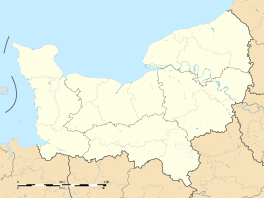Hiéville
| Hiéville | |
|---|---|

L'église Saint-Pierre
|
|
| Coordinates: 49°01′26″N 0°00′25″W / 49.0239°N 0.0069°WCoordinates: 49°01′26″N 0°00′25″W / 49.0239°N 0.0069°W | |
| Country | France |
| Region | Normandy |
| Department | Calvados |
| Arrondissement | Lisieux |
| Canton | Livarot |
| Area1 | 4.77 km2 (1.84 sq mi) |
| Population (2008)2 | 293 |
| • Density | 61/km2 (160/sq mi) |
| Time zone | CET (UTC+1) |
| • Summer (DST) | CEST (UTC+2) |
| INSEE/Postal code | 14331 /14170 |
| Elevation | 22–74 m (72–243 ft) (avg. 50 m or 160 ft) |
|
1 French Land Register data, which excludes lakes, ponds, glaciers > 1 km² (0.386 sq mi or 247 acres) and river estuaries. 2Population without double counting: residents of multiple communes (e.g., students and military personnel) only counted once. |
|
1 French Land Register data, which excludes lakes, ponds, glaciers > 1 km² (0.386 sq mi or 247 acres) and river estuaries.
Hiéville is a former commune in the Calvados department in the Normandy region in northwestern France. On 1 January 2017, it was merged into the new commune Saint-Pierre-en-Auge.
Graph of Hiéville population over time: 
French linguist writes that the etymology of Hiéville is similar to that of the commune Hiesville in the Manche department. Both names probably come from the word 'hedo' (derived from the Ancient Greek word for pleasure) and the Old French word 'ville', which originally referred to a rural estate or territory. Ville itself was derived from the Latin phrase 'villa rustica,' a countryside home.
...
Wikipedia


